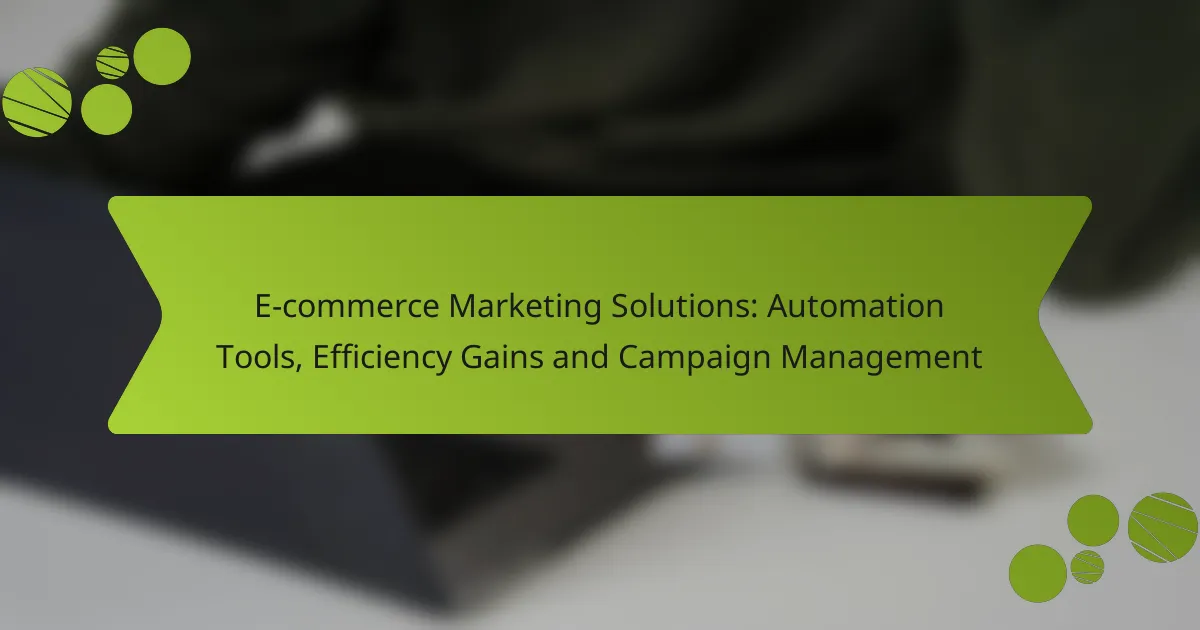E-commerce marketing solutions leverage A/B testing strategies to compare different campaign versions, ultimately enhancing conversion rates and user engagement. By focusing on data-driven optimization techniques such as customer segmentation and retargeting, businesses can effectively drive sales and build trust with their audience. Additionally, utilizing performance analysis tools provides valuable insights into user behavior and traffic sources, enabling continuous improvement of marketing strategies.

What A/B testing strategies improve e-commerce marketing?
A/B testing strategies enhance e-commerce marketing by allowing businesses to compare different versions of web pages or campaigns to determine which performs better. Effective testing can lead to improved conversion rates, better user engagement, and increased revenue.
Multivariate testing
Multivariate testing evaluates multiple variables simultaneously to identify the best combination of elements on a webpage. For instance, you might test different headlines, images, and call-to-action buttons all at once. This method provides insights into how various elements interact, but it requires a larger sample size to yield reliable results.
When implementing multivariate tests, ensure that you have enough traffic to support the complexity of the test. A common pitfall is running tests with insufficient data, which can lead to inconclusive results.
Split URL testing
Split URL testing involves creating entirely different URLs for each version of a webpage to compare their performance. This method is particularly useful for significant changes, such as redesigning a landing page. It allows for a clear distinction between the two versions, but it may require more technical setup and tracking.
To effectively use split URL testing, ensure that both versions are optimized for the same audience and that traffic is evenly distributed between them. Monitor key performance indicators (KPIs) closely to assess which version drives more conversions.
Sequential testing
Sequential testing is a method where changes are implemented one at a time, allowing for a clearer understanding of each modification’s impact. This approach is beneficial for gradual improvements, such as tweaking a product description or adjusting pricing strategies. However, it may take longer to reach conclusive results.
When using sequential testing, document each change and its outcomes to build a comprehensive understanding of what works best. Avoid making multiple changes at once, as this can complicate the analysis and obscure the effects of individual modifications.
Time-based testing
Time-based testing evaluates performance over specific periods to account for variations in user behavior. For example, testing a promotional campaign during peak shopping seasons versus off-peak times can yield different results. This strategy helps in understanding how timing affects conversion rates.
To implement time-based testing effectively, choose periods that reflect typical shopping behavior for your target audience. Analyze results not just by overall performance but also by time segments to identify trends and patterns.
Personalization testing
Personalization testing tailors content and offers to specific user segments based on their behavior, preferences, or demographics. This strategy can significantly enhance user experience and engagement, leading to higher conversion rates. For example, showing different product recommendations based on past purchases can be highly effective.
When conducting personalization testing, segment your audience carefully and ensure that the personalized content is relevant and valuable. Monitor the impact on user engagement and conversion rates to refine your approach continuously.

How to optimize e-commerce marketing campaigns?
To optimize e-commerce marketing campaigns, focus on data-driven strategies that enhance customer engagement and conversion rates. Key methods include customer segmentation, retargeting, and leveraging social proof to build trust and drive sales.
Utilizing customer segmentation
Customer segmentation involves dividing your audience into distinct groups based on shared characteristics such as demographics, purchasing behavior, or preferences. This allows for tailored marketing messages that resonate more effectively with each segment.
To implement segmentation, analyze your customer data and identify key traits. For example, you might create segments for first-time buyers, repeat customers, and high-value clients. Tailor your campaigns to address the specific needs and interests of each group, which can lead to higher engagement and conversion rates.
Implementing retargeting strategies
Retargeting strategies focus on re-engaging users who have previously interacted with your website but did not complete a purchase. By displaying targeted ads to these users across various platforms, you can remind them of products they viewed and encourage them to return.
Consider using dynamic retargeting ads that showcase specific products users have shown interest in. This personalized approach can significantly increase the likelihood of conversion. Set a reasonable retargeting window, typically ranging from a few days to a couple of weeks, to maintain relevance without overwhelming potential customers.
Leveraging social proof
Social proof, such as customer reviews, testimonials, and user-generated content, can significantly influence purchasing decisions. By showcasing positive feedback and experiences from existing customers, you build trust and credibility with potential buyers.
Incorporate social proof into your marketing campaigns by highlighting top reviews on product pages, sharing testimonials in email campaigns, or displaying user-generated content on social media. Aim to gather authentic feedback and respond to customer inquiries, as this engagement can further enhance your brand’s reputation and drive sales.

What tools enhance performance analysis in e-commerce?
Performance analysis in e-commerce is significantly improved by using specialized tools that provide insights into user behavior, traffic sources, and conversion rates. These tools help businesses optimize their marketing strategies and enhance overall performance.
Google Analytics
Google Analytics is a powerful tool that tracks website traffic and user behavior, offering detailed reports on visitor demographics, acquisition channels, and conversion rates. By setting up goals and e-commerce tracking, you can measure the effectiveness of your marketing campaigns and identify areas for improvement.
To maximize its benefits, regularly review key metrics such as bounce rate, average session duration, and conversion rate. Utilize features like custom dashboards and alerts to stay informed about significant changes in performance.
Hotjar
Hotjar provides visual insights into user interactions through heatmaps, session recordings, and feedback polls. This tool allows you to see where users click, scroll, and spend time on your site, helping you understand their behavior and preferences.
Implementing Hotjar can reveal usability issues and areas that need optimization. Use the feedback feature to gather direct insights from users, which can guide your design and content strategies effectively.
Klaviyo
Klaviyo is an email marketing platform that integrates seamlessly with e-commerce sites, enabling personalized communication based on user behavior and purchase history. It allows you to segment your audience and automate campaigns, enhancing engagement and conversion rates.
To leverage Klaviyo effectively, focus on creating targeted email flows for abandoned carts, post-purchase follow-ups, and promotional campaigns. Monitor key performance indicators like open rates and click-through rates to refine your strategies continuously.

What are the key metrics for e-commerce campaign performance?
The key metrics for e-commerce campaign performance include conversion rate, average order value, and customer acquisition cost. These metrics help businesses evaluate the effectiveness of their marketing strategies and identify areas for improvement.
Conversion rate
Conversion rate measures the percentage of visitors who complete a desired action, such as making a purchase. A higher conversion rate indicates that your marketing efforts are effectively persuading potential customers to buy. Typically, e-commerce sites aim for a conversion rate between 1% and 5%, but this can vary based on the industry.
To improve your conversion rate, consider A/B testing different elements of your website, such as product descriptions, images, and call-to-action buttons. Avoid common pitfalls like cluttered layouts or unclear messaging, which can deter potential buyers.
Average order value
Average order value (AOV) calculates the average amount spent each time a customer places an order. Increasing AOV can significantly boost revenue without needing to acquire more customers. AOV is typically influenced by factors such as pricing strategies, product bundling, and upselling techniques.
To enhance AOV, implement strategies like offering discounts on minimum purchase amounts or suggesting complementary products at checkout. Monitoring AOV regularly can help identify trends and inform pricing adjustments.
Customer acquisition cost
Customer acquisition cost (CAC) represents the total cost of acquiring a new customer, including marketing expenses and promotional offers. Understanding CAC is crucial for evaluating the efficiency of your marketing campaigns. A lower CAC indicates a more effective strategy, while a higher CAC can signal the need for optimization.
To manage CAC effectively, track your marketing spend across different channels and analyze which ones yield the best return on investment. Avoid overspending on channels that do not convert well, and focus on optimizing your most profitable marketing avenues.

How to create a decision matrix for A/B testing?
A decision matrix for A/B testing helps prioritize test variations based on specific criteria. It allows teams to evaluate potential changes systematically, ensuring that the most impactful tests are conducted first.
Define testing goals
Clearly defined testing goals are essential for effective A/B testing. Goals should be specific, measurable, achievable, relevant, and time-bound (SMART). For example, a goal might be to increase the conversion rate of a product page by 15% within three months.
When setting goals, consider what aspects of the user experience you want to improve, such as click-through rates, engagement levels, or sales figures. This focus will guide your testing efforts and help you measure success accurately.
Identify key performance indicators
Key performance indicators (KPIs) are metrics that will help you assess the effectiveness of your A/B tests. Common KPIs include conversion rates, average order value, and customer retention rates. Selecting the right KPIs ensures that you are measuring what matters most to your business objectives.
To choose effective KPIs, align them with your testing goals. For instance, if your goal is to improve user engagement, metrics like time spent on page or bounce rate may be more relevant than sales figures. Regularly review these indicators to refine your testing strategy and optimize performance.








